For vet school hopefuls, new program provides essential experience
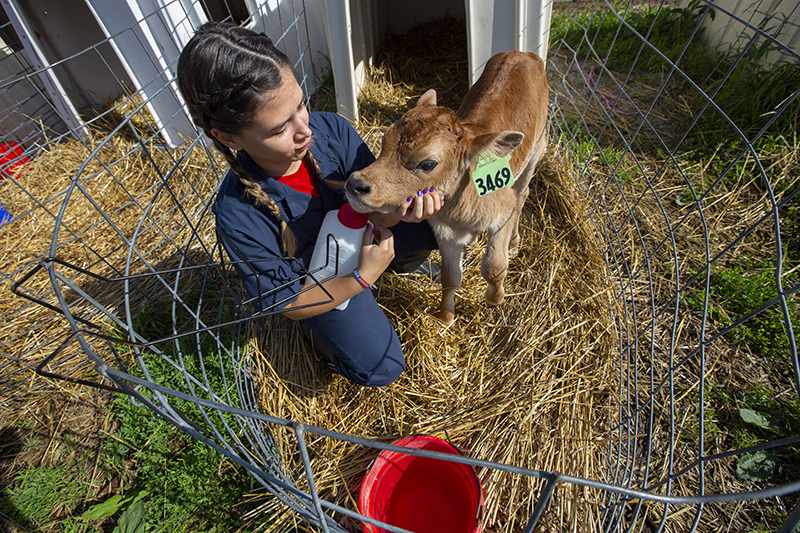
Ariana Sanchez, sophomore in animal ecology, checks on a dairy calf at the Dairy Science Farm. She is participating in the College of Veterinary Medicine's Food Animal Summer Experience, a program designed to help diversity the veterinary school's student populations. Photos by Christopher Gannon.
Ariana Sanchez would dress up like a veterinarian as far back as first grade. Claudia De Leon loved animals so much as a kid, her mother hid the litter boxes so they could have cats in their apartment. Seeing the insides of a fistulated cow at the Texas State Fair about a decade ago hooked J'Haira Rhodes on large animals.
But beyond being Iowa State undergraduates who have long dreamed of going to veterinary medicine school, Sanchez, De Leon and Rhodes also share a lack of extensive hands-on experience with a wide variety of animals. They're changing that this summer. A new program by the College of Veterinary Medicine is providing them and five other students of color an opportunity to care for food animals and job shadow veterinarians, a background that's needed for vet school admission but often difficult to acquire.
"It's what we've been looking for," Sanchez said as she nursed baby calves at the Dairy Science Farm. "This program will change our lives, I think."
The 10-week Food Animal Summer Experience program covers the room and board of eight Iowa State students who have interest in applying to the College of Veterinary Medicine but limited experience with animals. They spend their mornings working alongside staff on the animal science department's teaching and research farms, rotating among dairy, poultry, swine, beef and sheep. In the afternoons, they're at the college's hospitals and clinics observing all aspects of veterinary care.
"The other day we got to castrate pigs," De Leon said. "That was fun."
Opening doors
Most vet schools require for admission some level of experience with animals or veterinary work. At Iowa State, it's 200 hours. The program, which runs May 29-Aug. 3, is designed to satisfy the 200-hour requirement and help students understand the day-to-day duties of veterinarians.
"Both learning what you want to do as well as what you don't want to do is important," said Dr. Alex Ramirez, associate professor of veterinary diagnostic and production animal medicine and the interim assistant dean of academic and student affairs.
Veterinary medicine is "one of the whitest professions," Ramirez said, and the college in recent years has become more aggressive in seeking to diversify its student body. It hired a recruiter and temporarily suspended the in-person interviews once required for a successful application, a move that remains under consideration moving forward, he said.
Those efforts have yielded a sharp increase in overall applications, Ramirez said. Last year's entering class included 11 students who identified as underrepresented. This fall's class includes 22 underrepresented students, he said. He is hopeful the Food Animal Summer Experience will help maintain a pipeline of diverse applicants.
"The more backgrounds and diversity you bring into any profession, the more open-ended you are, the more you think outside of the box and improve outcomes," Ramirez said.
The college funded the program's inaugural year but is seeking sponsors to sustain it, he said.
'10 out of 10'
The eight women in the program, none of them from Iowa, were among nearly two dozen applicants, said Dr. Jessie Juarez, a veterinarian and lecturer in animal science who is coordinating the Food Animal Summer Experience. Students applying were asked to rate their interest in being a veterinarian on a scale of 1 to 10.
"They were all 10 out of 10," Juarez said of the students selected.
The group has been highly engaged, asking tons on questions, she said. Their excitement for working with different species for the first time is obvious.
"I guess I'd forgotten that initial feeling, so it's kind of fun to relive that with them," Juarez said.
Rhodes said she's appreciated learning the different practices at each farm and watching surgery at the hospital. She's also been impressed by how involved Veterinary Medicine students are in animal care. The program has been an awesome opportunity, she said.
The number of students involved in future summers probably couldn't increase dramatically without overwhelming the staff at the teaching farms, who have been enthusiastic partners, Juarez said. A smaller group also allows students to connect with each other. That's been one of the highlights for Sanchez, who noted they may end up in vet school together someday soon.
"We're going to see each other in the future," she said. "It just makes me more excited for what's to come."
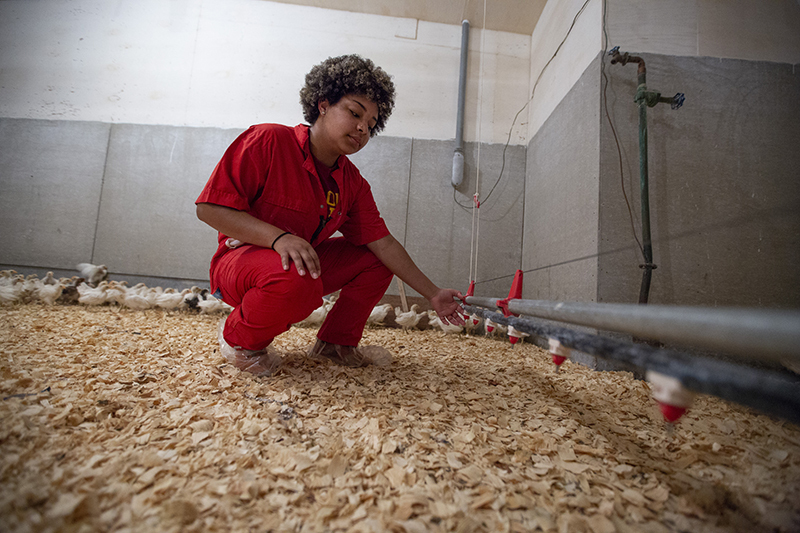
J’Haira Rhodes, junior in animal science, inspects a water supply for young white leghorns at the Poultry Science Farm. She is participating in the College of Veterinary Medicine's Food Animal Summer Experience. She's one of eight ISU students of color in the College of Veterinary Medicine's new Food Animal Summer Experience program.
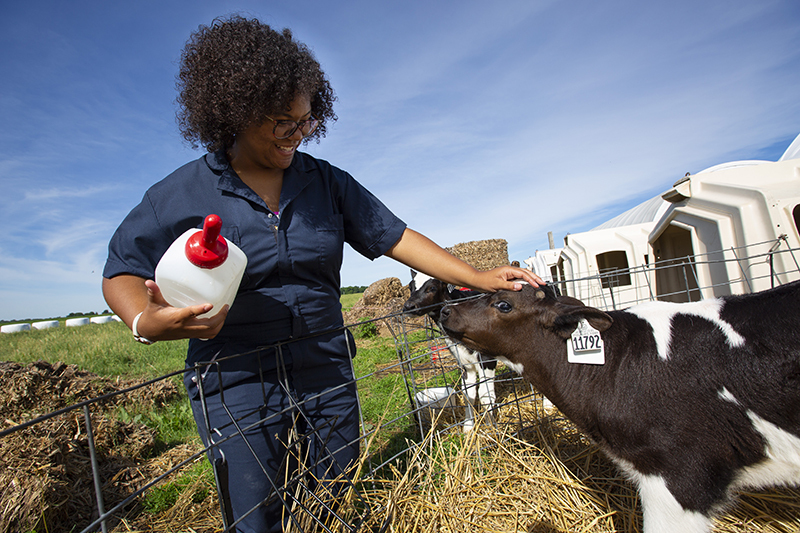
Claudia Deleon, sophomore in animal science, greets a dairy calf at the Dairy Science Farm. She's one of eight students of color from Iowa State in the inaugural Food Animal Summer Experience, a College of Veterinary Medicine program that aims to help develop a pipeline of diverse vet school applicants.
Floating islands project studies water quality, pollinator plants
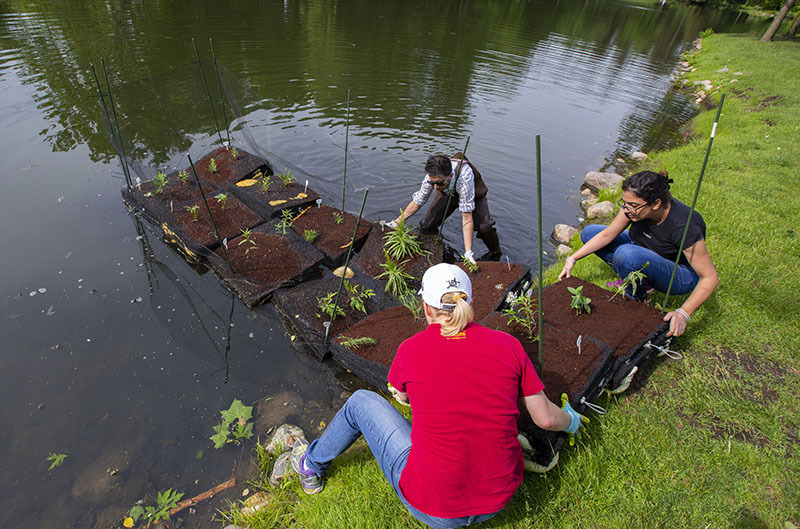
(clockwise from top) Sustainable environments graduate students Kaveh Abbasi Hafshejani, Diba Malekpour and Paige Adams launch a floating island in Lake Laverne. Photos by Christopher Gannon.
Islands have returned to Lake LaVerne.
The sustainable environments interdisciplinary graduate program’s floating islands research project is back on Iowa State's landmark lake for the first summer since 2015. While the project still measures nutrient uptake from the water, this year’s research adds a new twist. Pollinator plants are being used to determine if floating islands could have a twofold benefit by helping threatened insects such as bees and butterflies.
“This summer we’re going to assess the performance of pollinator plants, which are different from the plants we used last time,” said Mimi Wagner, director of the sustainable environments program and associate professor of landscape architecture. “These plants have not been tested in the literature for nutrient uptake.”
The sustainable environments program is leading this interdisciplinary research, which includes the departments of civil, construction and environmental engineering and entomology.
“Our long-term goal has always been to develop this practice for farmers and rural landowners to use on farm ponds,” Wagner said. “Farm ponds are common in Iowa and many of those have high nutrient problems.”
Twelve floating islands, each a 2-foot cube, form a larger island on the lake. Bird netting surrounds the islands so geese don’t eat the plants. The base of each island is formed with pond filter material and a layer of marine foam to provide flotation. Holes drilled into the filter material are filled with peat moss and used to contain the individual pollinator plants. This year, 12 pollinator plant species – a different species on each island – are being used for the project. Their roots wick up nutrients from the lake. ISU entomologists are providing insight into the pollinator plants, which include common milkweed, wild bergamot, New England aster and swamp milkweed; and associated insects.
“Floating islands already help farm ponds reduce excess nutrient levels, so why not also help by providing more pollinator habitat acres, too?” Wagner said.
You may have noticed that Lake LaVerne has lost some of its algae cover in recent weeks. That's because crews with facilities planning and management applied liquid aluminum sulfate (alum), which binds phosphorous suspended in the water and settles it to the bottom of the pond. This helps clear the water and slows the growth of algae, but it’s a temporary treatment.
Wagner says 15 percent of a pond area would need to be covered with vegetated floating islands in order to positively impact water quality. These research floating islands cover only a small percentage of Lake LaVerne.
The results of the floating islands research, however, will be valuable in the scale-up for farm ponds.
An Chen and Kaoru Ikuma, both assistant professors of civil, construction and environmental engineering, are helping the team study structure, flotation, water quality and future scaling.
“In the past, materials such as bamboo, concrete and polyester have been used to construct the island,” Chen said. “My research goal is to come up with a cost-effective structural supporting system for an island with a given size.”
The floating islands will remain on the lake through early October, when they will be removed to analyze nutrient content. Signage will be placed around the lake describing the project for passersby.
“Some of our research goals are to quantitatively examine how much improvement in water quality these floating islands can provide and to optimize the environmental benefits of the islands,” Ikuma said.
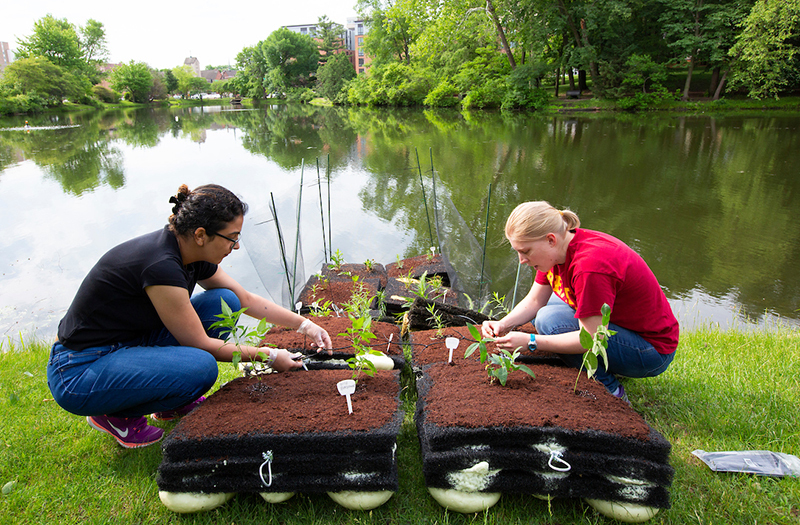
(left) Diba Malekpour and Paige Adams, graduate students in sustainable environments, assemble the sections of the floating island prior to launch on Lake LaVerne.
Scholarship fund is graduates' gift of choice since 2012
You won't find a campus plaque denoting any recent senior class gifts. Instead, Iowa State's newest graduates have been supporting a scholarship fund.
Launched by the class of 2012, the endowed Senior Class Gift Scholarship has doled out eight scholarships since 2014, including three in 2017-18. Seniors who have filled out a FAFSA (Free Application for Federal Student Aid) are eligible for the award, typically $500 each.
"Hopefully, the amount of each award will grow as the endowment grows," said Mary Evanson, executive director of annual and special gifts at the ISU Foundation. "The scholarship criteria are pretty broad. The class that established the fund wanted us to be able to cast as wide a net as possible."
The endowed fund sits just a couple dollars shy of $73,000. Graduates from 2017 (194 total) contributed nearly $13,000 to the fund. Among the 2018 spring graduates, 135 new alumni already have donated more than $10,000 to the scholarship fund.
"I think by the time we put this in front of the upcoming fall graduates, they likely will far exceed the amount that was raised the year before," Evanson said.
Including the class gift contributions, 2018 graduates have donated nearly $25,000 overall. Evanson said some gifts were designated for specific departments and organizations.
"Some of them are saying 'my department is important to me,' or 'the student organization I belonged to really is my passion,'" Evanson said.
A scholarship funded by seniors, for seniors, hits home, Evanson said. It's something the foundation emphasizes when they contact juniors about the opportunity to apply.
"I think it's something everyone who has been a student at some point can relate to -- whether it's help paying for books, paying tuition or getting an extra experience like studying abroad," Evanson said. "We're seeing increased importance and increased need for it on campus."
Gardens to host Pollinator Fest
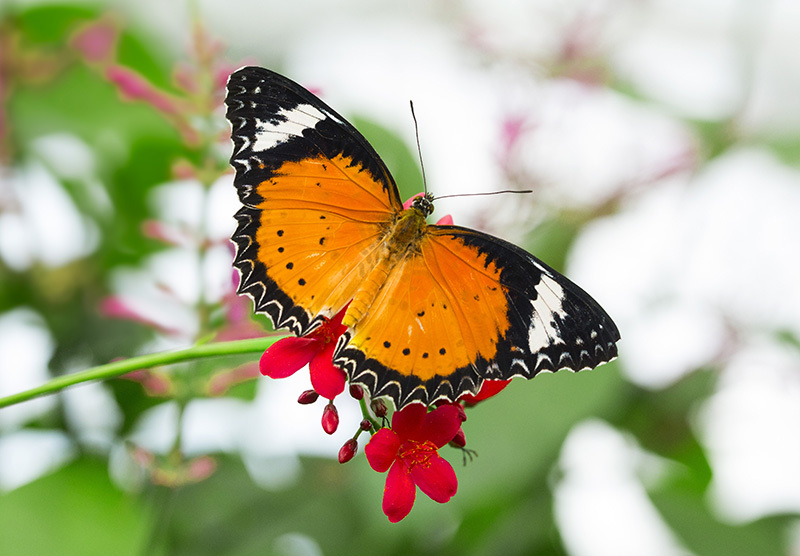
Photo by Christopher Gannon.
Reiman Gardens will host a series of activities to celebrate National Pollinator Week on Saturday, June 23 (10 a.m.-2 p.m.). Campus groups are among the organizations participating in Pollinator Fest, including ISU's pollinator working group, entomology graduate student organization and graduates in evolutionary biology and ecology. Educational exhibits, crafts and interactive displays suitable for all ages are planned. Admission is free.
